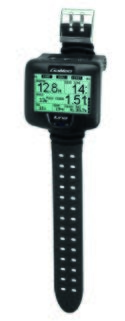Dive computer
A dive computer is an electronic instrument that primarily fulfills two tasks: During the dive, the current dive depth and accumulated dive time are measured and shown on a display. Furthermore, the nitrogen saturation in the diver's body is calculated based on the dive profile and the resulting decompression information such as remaining no-stop time, deco, deep and safety stops are displayed.
Contents
Basic knowledge for Open Water Diver* (OWD*)
Displayed data
Depending on the brand, modern dive computers show a large amount of measured values on their displays. At least the current diving depth, maximum diving depth and current dive time must be displayed. In addition, temperature, ascent rate and partial pressure of oxygen are often displayed. If the dive computer can be connected to a hose or can read the cylinder pressure via a radio transmitter (so-called air-integrated dive computer), this and the remaining bottom time calculated from it will also be displayed. Some models also contain a digital compass.
The data is usually not only displayed, but also saved in the dive computer and can be transferred to a PC or smartphone after the dive.
Decompression calculation
In addition to displaying the measured data, these are used to calculate the nitrogen saturation and any necessary stops. On the basis of these calculations, the display shows the remaining no-stop time, deco, deep and safety stops to be observed, and the necessary ascent time to the surface.
Please note that these values are the result of model calculations based on years of tests and statistics. They are generally very reliable, but they cannot apply to all people and not to the same person every day, because not all influencing factors are known.
Usage
The sensor technology and electronics of modern dive computers is now so sophisticated that it is no longer necessary to carry additional depth gauges, diving watches, dive tables or a compass. Even in the event of a failure of your own dive computer, you can use the deco information of the dive partner's computer in an emergency, since you are always diving in a team together. For this reason, it is compulsory to carry a dive computer with almost all dive centers worldwide. In case of a computer failure, the ascent must be started immediately and the dive must be ended preferably with an extended safety stop.
Before the dive, you should check whether the battery has enough capacity. Switch on the computer and check the display. In any case, familiarize yourself with the operating instructions of your dive computer so that you understand the information displayed and can act accordingly.
It is absolutely mandatory to adhere to the displayed deco stops, even if the computers of your diving partners show other values. On the one hand, dive computers use slightly different models to calculate these values and they also include existing residual nitrogen saturations from previous dives, which can vary from diver to diver. Your dive computer is a personal piece of equipment that you should not exchange with any of your diving partners and it should always be with you, as it calculates your nitrogen saturation also outside the water and takes this into account during your next dive. On the air plane, you must not stow your dive computer in your luggage, you must take it with you into the aircraft cabin. Do not pack it airtight. Always stay some minutes away from your no-decompression limit, in case of doubt, extend the safety or deco stop.
While a dive computer is not a 100% guarantee of accident-free diving, it can reduce the risk of decompression sickness if used correctly. Please also note the safety instructions in the article decompression calculation when using a dive computer.
